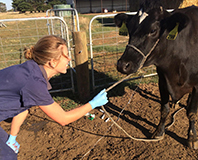Read the latest information on
Foot-and-mouth disease
For Sarah Matthews, a mixed-practice vet working in Warrnambool, biosecurity is an important part of her daily work routine. Her diligent efforts in preventing the spread of diseases is a reminder for producers to check that their own vets are taking biosecurity seriously.
A typical day for Sarah may involve visits to a number of properties located in different parts of the Warrnambool region and could include a range of different tasks, from calvings, to investigations of sick goats or a stitch up. As a vet servicing so many properties, a good biosecurity routine is paramount to Sarah’s practice.

Your vet should take biosecurity seriously
“I see a lot of cases of calf scours and it is vitally important that I stick to my biosecurity regime every time to prevent disease transmission between properties. I add extra biosecurity precautions onto my usual regime if I am aware of, or if I have high suspicions that a farm has, a nasty bug such as multi-drug resistant Salmonella,” Sarah said.
“Every visit I will wash my hands and arms with iodine prior to applying gloves. I wear gloves at all times on site and where possible I dispose of my rubbish on site. Before leaving the property I will wash and disinfect my gumboots with iodine and hot water, clean and disinfect my stethoscope, thermometer, lameness ropes and halters.
“Once a fortnight I will also re-wash my ropes and halters in the washing machine. I always change my overalls between farms and if I suspect high levels of contamination (e.g. calvings, down cow or calf shed cases), I wear waterproofs as they are easier to clean,” Sarah said.
These practices may sound thorough enough, but in some instances Sarah takes additional biosecurity measures.
“When multi-drug resistant Salmonella could be involved I use additional precautions, including not driving my vehicle off the main driveway to avoid contamination. Wherever possible, I use disposable equipment or borrow the farmer’s own non-disposable equipment that can be left on the property. On suspect farms, I will use Virkon disinfectant to spray down all my equipment and car tyres before leaving.”
For more help on biosecurity practices to help prevent the introduction or spread of diseases on your property, visit the Farm Biosecurity website.